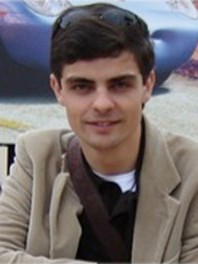resumo
The diastereoselective photodependent isomerization equilibrium of E/Z-1,3-ditolyl-5-[3-oxobenzofuran-2(3H)-ylidene] imidazolidine-2,4-dione (5) is reported. Both diastereomers E-5 and Z-5 are stereochemically stable in solid state but show significant photosensibility in solutions of halogenated solvent. The photoisomerization equilibrium of E/Z-5 is therefore deduced from the H-1 NMR profile after visible-light irradiation of both E-5 and Z-5 samples. The results of the kinetic study, monitored by UV-HPLC, reveal that the E/Z equilibrium is diastereoselective and photodependent, being the transformation E -> Z proceeding faster than that of Z -> E, and the E/Z ratio at the equilibrium depends on the used solvent, light source, and temperature. Both diastereomers are visible-light photosensitive tending to coexist together in equilibrium solutions at a determined ratio, which is always in favor of the Z-product assuming a minimum thermodynamic energy and an increased entropy of the system. Time-dependent density functional theory calculations suggest that the photoisomerization mechanism proceeds via a conical intersection involving the first-excited state: Upon irradiation, the E-5 isomer is excited to the S1 potential energy surface, where it relaxes through rotation of the C=C bond and reaches a conical intersection with the ground-state potential energy surface, thus yielding the Z-5 isomer. Copyright (C) 2014 John Wiley & Sons, Ltd.
palavras-chave
ISOMERIZATION; DERIVATIVES; STILBENE; PROTEIN
categoria
Chemistry
autores
Talhi, O; Lopes, GR; Santos, SM; Pinto, DCGA; Silva, AMS
nossos autores
agradecimentos
Thanks are due to the University of Aveiro, Fundacao para a Ciencia e a Tecnologia (Portugal), the European Union, Quadro de Referencia Estrategico Nacional, Le Fonds europeen de developpement regional, Programa Operacional Factores de Competitividade (COMPETE), for funding the Organic Chemistry Research Unit (Quimica Organica, Produtos Naturais e Agroalimentares; project PEst-C/QUI/UI0062/2013), and the Portuguese National NMR Network (RNRMN). The authors also thank the (European Community's) Seventh Framework Programme (FP7/2007-20139 under grant agreement no 215009) for the financial support.


